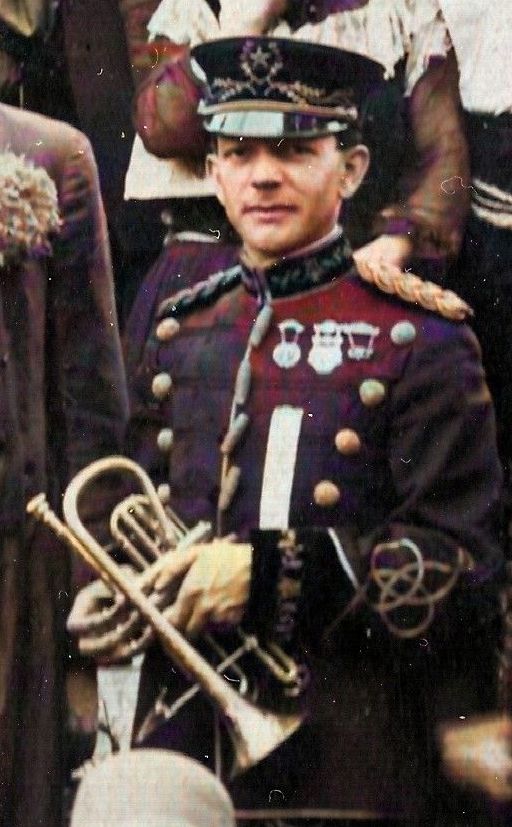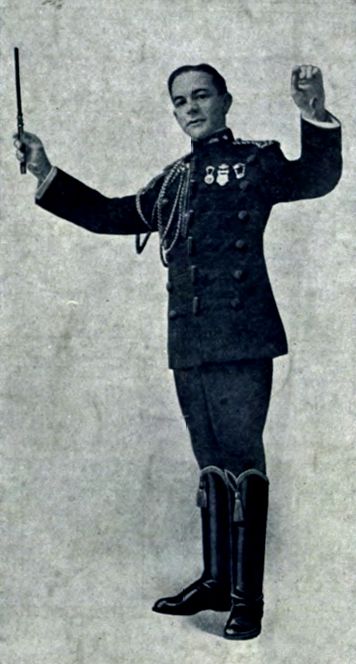===
Frederick Clayton Lampham was born in Rochester, New York in 1881, the son of a barber in the Second Ward. He studied music at the Rochester Free Academy, becoming an accomplished cornet player. A soloist at concerts before graduation, when city-directory canvassers inquired at the end of 1899, he gave his profession as musician. The following year, he published his first song, "Since My Darling's Gone," for which he composed the music and penned the lyrics, leaving the arrangement to a more experienced pro.
During the succeeding decade, Lampham helped make ends meet by teaching music, but bankrupted himself operating a music store for a short time. His main line was performance as a cornetist, a conductor and a bandleader. In 1902, he assembled his first large "Cadet Band" for concerts. Two years later, a small-town paper referred to the not-yet-23-year-old as the "world's youngest bandmaster." At the time, to be a band was nearly synonymous with being a brass band. The pinnacle of accomplishment and fame and was represented by the "March King" John Philip Sousa, who had first published his own music three decades earlier and had led the U.S. Marine Band and his own eponymous commercial band. Lampham's outfit followed the uniformed example of Sousa's touring company, eventually dubbing his men, unoriginally, the "Red Hussars."
Not all were men, however. The Red Hussar Band would typically feature a female vocalist---originally, Lampham's fiancee, Fannie May Puffer, a soprano, a solo pianist and a flautist. Multi-talented, she would later direct music for a photoplay, and would reappear fronting the Hussars occasionally in the 1910s, 1920s and 1930s.
By 1909, the "Red Hussar Band and Extravaganza Company" consisted of "30 artists," as Lampham insisted that each could competently solo, as he typically did each show. Their agent flogged them in "The Billboard" magazine as "the musical sensation of the century, a carnival of soloists combining in a human organ." They were essentially based at the Ontario Beach Park resort, where they played the bandshell all summer, a return engagement from the prior year.
Publicity led to gigs over an ever-wider area; Lampham's band eventually performed in every corner of New York State and at resorts in Connecticut. They played concert halls, dance auditoriums and vaudeville theaters, and at county and state fairs, amusement parks and trade shows. They were busiest in their hometown. Lampham wrote and arranged "The City Beautiful" march and two-step to honor Rochester's 1912 centennial, presenting the original manuscript to Mayor Edgerton at the festivities, and copyrighting it the following year. In April 1917, contemporaneous with Leonard Wood's World War I preparedness campaign, Lampham led his band in a patriotic spectacle featuring his original composition "Hurrah for Old Glory." The Red Hussars would perform the piece again at Ontario Beach in July.
Despite the negative connotations of the color red and the rejection of militarism after the war, the Hussars hung onto their name and their dated uniforms until the early 1930s. They did freshen their repertoire, however, performing everything "from classical overtures to modern jazz," now referred to as a novelty band and orchestra. The outfit slimmed down to 20 pieces by 1920, but to meet the Jazz Age, a saxophone sextet was added. They also introduced their first regular female player, Rochester's Deva Ellsworth on bass horn. Lampham demonstrated his willingness to keep up with popular music by composing "Honey Mine," a number for the vaudeville revue "Fads and Fashions of 1921." The band's success and promotion landed them their first engagement in New York City in 1920, followed by gigs at Capitol Park, "Connecticut's Coney Island" at Hartford; at Savin Rock in West Haven; and at Danbury.
In the first half of the 1930s, the now sixteen-piece orchestra played summers at the real Coney Island, and began promoting itself as Lampham's Coney Island Band or Luna Park Band. It was the era of the crooner and the "girl singer," and female leads included Elizabeth Roderick around 1925, Mildred O'Done from 1930 to 1935, Pauline Stevens from 1935, and occasionally Fannie Lampham. In the late 1930s, they rebranded as the Exposition Band and, just before World War II, as the Scotch Highlander Band.
One of the photographs depicts several members of Clayton Lampham's "Red Hussar Band," probably at a county fair or circus, with comic performers dressed as clowns and "keystone" cops and---manifesting the racial insensitivity of the time---as Mexican campesinos and blackface drag characters. Lampham stands to the right of the ringmaster.
===
Frederick Clayton Lampham was born in Rochester, New York in 1881, the son of a barber in the Second Ward. He studied music at the Rochester Free Academy, becoming an accomplished cornet player. A soloist at concerts before graduation, when city-directory canvassers inquired at the end of 1899, he gave his profession as musician. The following year, he published his first song, "Since My Darling's Gone," for which he composed the music and penned the lyrics, leaving the arrangement to a more experienced pro.
During the succeeding decade, Lampham helped make ends meet by teaching music, but bankrupted himself operating a music store for a short time. His main line was performance as a cornetist, a conductor and a bandleader. In 1902, he assembled his first large "Cadet Band" for concerts. Two years later, a small-town paper referred to the not-yet-23-year-old as the "world's youngest bandmaster." At the time, to be a band was nearly synonymous with being a brass band. The pinnacle of accomplishment and fame and was represented by the "March King" John Philip Sousa, who had first published his own music three decades earlier and had led the U.S. Marine Band and his own eponymous commercial band. Lampham's outfit followed the uniformed example of Sousa's touring company, eventually dubbing his men, unoriginally, the "Red Hussars."
Not all were men, however. The Red Hussar Band would typically feature a female vocalist---originally, Lampham's fiancee, Fannie May Puffer, a soprano, a solo pianist and a flautist. Multi-talented, she would later direct music for a photoplay, and would reappear fronting the Hussars occasionally in the 1910s, 1920s and 1930s.
By 1909, the "Red Hussar Band and Extravaganza Company" consisted of "30 artists," as Lampham insisted that each could competently solo, as he typically did each show. Their agent flogged them in "The Billboard" magazine as "the musical sensation of the century, a carnival of soloists combining in a human organ." They were essentially based at the Ontario Beach Park resort, where they played the bandshell all summer, a return engagement from the prior year.
Publicity led to gigs over an ever-wider area; Lampham's band eventually performed in every corner of New York State and at resorts in Connecticut. They played concert halls, dance auditoriums and vaudeville theaters, and at county and state fairs, amusement parks and trade shows. They were busiest in their hometown. Lampham wrote and arranged "The City Beautiful" march and two-step to honor Rochester's 1912 centennial, presenting the original manuscript to Mayor Edgerton at the festivities, and copyrighting it the following year. In April 1917, contemporaneous with Leonard Wood's World War I preparedness campaign, Lampham led his band in a patriotic spectacle featuring his original composition "Hurrah for Old Glory." The Red Hussars would perform the piece again at Ontario Beach in July.
Despite the negative connotations of the color red and the rejection of militarism after the war, the Hussars hung onto their name and their dated uniforms until the early 1930s. They did freshen their repertoire, however, performing everything "from classical overtures to modern jazz," now referred to as a novelty band and orchestra. The outfit slimmed down to 20 pieces by 1920, but to meet the Jazz Age, a saxophone sextet was added. They also introduced their first regular female player, Rochester's Deva Ellsworth on bass horn. Lampham demonstrated his willingness to keep up with popular music by composing "Honey Mine," a number for the vaudeville revue "Fads and Fashions of 1921." The band's success and promotion landed them their first engagement in New York City in 1920, followed by gigs at Capitol Park, "Connecticut's Coney Island" at Hartford; at Savin Rock in West Haven; and at Danbury.
In the first half of the 1930s, the now sixteen-piece orchestra played summers at the real Coney Island, and began promoting itself as Lampham's Coney Island Band or Luna Park Band. It was the era of the crooner and the "girl singer," and female leads included Elizabeth Roderick around 1925, Mildred O'Done from 1930 to 1935, Pauline Stevens from 1935, and occasionally Fannie Lampham. In the late 1930s, they rebranded as the Exposition Band and, just before World War II, as the Scotch Highlander Band.
One of the photographs depicts several members of Clayton Lampham's "Red Hussar Band," probably at a county fair or circus, with comic performers dressed as clowns and "keystone" cops and---manifesting the racial insensitivity of the time---as Mexican campesinos and blackface drag characters. Lampham stands to the right of the ringmaster.
Family Members
Sponsored by Ancestry
Advertisement
Advertisement




